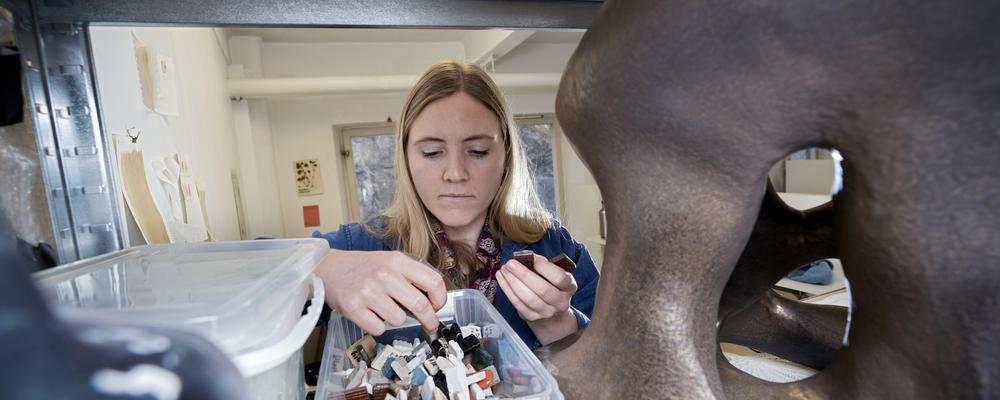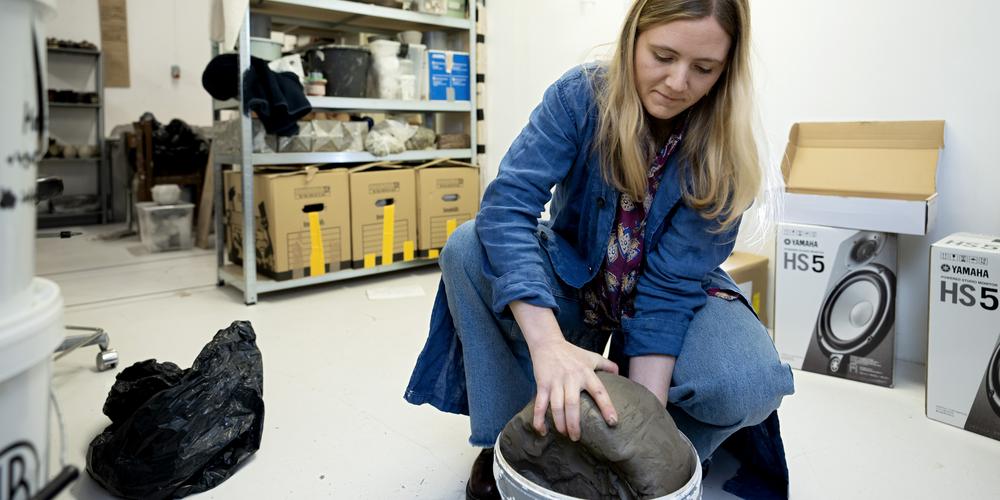
Marilen wants to feel a connection to the material
For Marilen Rauch, studying ceramics at HDK-Valand – Academy of Art and Design took her artistic work in a completely new direction. She worked with free-form sculptures before. Now she focuses on the material, the places where it can be found – and the sounds that go with it.
Marilen Rauch has had her workshop at the old Klippan sugar mill, right next to the Röda Sten art centre and the Göta Älv river, for more than a year now. She shares the premises with six other Gothenburg-based ceramicists, most of whom – like Marilen – have master’s degrees from HDK-Valand. Marilen doesn’t spend all that much time at her workshop. She’s hardly been here since she graduated. Instead, she’s been away on various artist residencies and scholarship trips to countries such as South Korea, Estonia and Denmark. But now she’s planning to stay in Gothenburg, at least for a while. A performance at the artist-run cultural scene 3:e Våningen will be happening will soon take place.
“Yes, I’m going to be part of a concert programme named Oljud, Noise. Not that I’d call myself a sound artist. But I do enjoy combining ceramics with other things I like. Like sound,” says Marilen.
This is how she works these days. She used to create free-form sculptures and enjoyed “just doing things”, without really having to think too much. But her entire artistic practice altered fundamentally at HDK-Valand. She now describes her works as conceptual. The turning point came when she relocated to Gothenburg and realised that more or less the whole city rests on clay.
“There’s so much of it! I started digging at Delsjön lake initially, and collected clay there. Then I found some on construction sites near the school. At Nääs and on the island of Brännö,” says Marilen.
“Of course, I was able to collect materials from the storeroom at the school,” she continues, “but it seemed strange to do that when I could find clay all over the place. I want a link to the materials I use.”

Actually collecting the clay took some time. As did cleaning it. Around the same time, Marilen began recording sounds from the places where she’d collected her clay. Ultimately, this process culminated in her thesis entitled “Material Soundscapes”. This is an interactive installation where onlookers can touch the clay, relate to its original location and even listen to it.
The love for clay
Marilen says she’s driven by a desire to experiment. That she’ll go on mixing, blending and exploring other materials and art forms – but without abandoning clay. She explains how she developed an interest in ceramics when she was ten. Back then, she was a student at a school in Esslingen, Germany, not far from Stuttgart, and creativity was part of day-to-day life.
“I’ve been working with it ever since. It was love at first sight,” says Marilen.
Even so, she decided initially to pursue a different path in terms of her education. Not only was there no art school offering ceramics anywhere near her, but she also enjoyed graphic design. She ended up with a bachelor’s degree in graphic design from a university in Mainz. But she also spent an exchange year in Gdańsk, Poland, just so that she could pursue ceramics as well. And then she moved to Sweden – for the first time.
“I studied at Nyckelviksskolan in Stockholm, and heard about HDK-Valand and Konstfack, the University of Arts, Crafts and Design. I applied to both, but I wasn’t successful," says Marilen.
She headed back to Germany. But before long, she decided to give Gothenburg another go.
“I arrived here just as the pandemic was starting. That was an unusual time, but we got to spend time at the incredible ceramics studio at the academy. So things were better here than in Germany, where everything was locked down,” she says.
Marilen doesn’t know whether the pandemic was to blame, but she’d have liked to see more contact across programme boundaries during her studies at HDK-Valand.
“Study programmes in Germany are more interdisciplinary and you have more opportunities to choose different courses. That said, our little ceramics team was great, we enjoyed what we were doing, and we were able to collaborate with the textile art and jewellery art programmes to an extent.”
By: Camilla Adolfsson